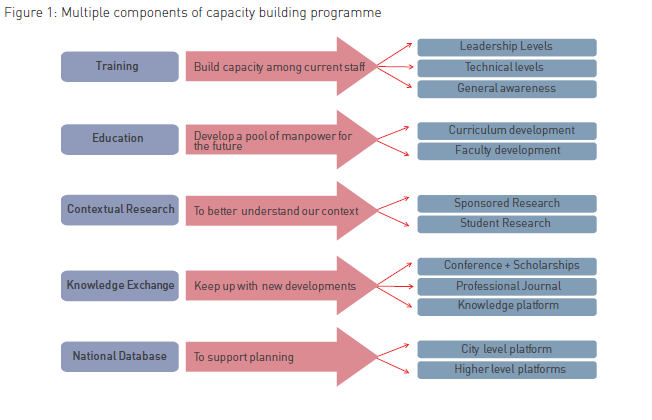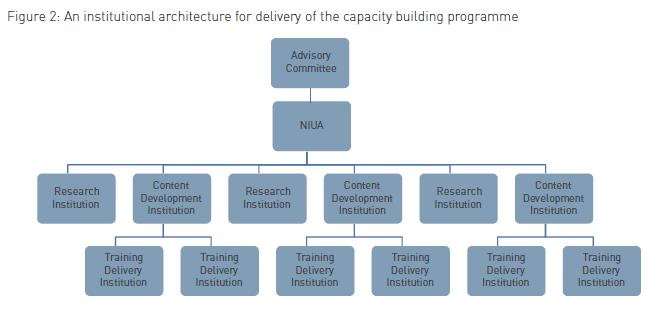The Government has taken up a mega-programme for developing 100 Smart Cities and also rejuvenating and transforming 500 cities in the country. An amount of R98000 crores (approx $16 billion) has been earmarked for this programme over the next five years. The State Governments are expected to contribute a matching amount. A large programme of this nature has been necessitated due to a realisation that improving our urban areas is critical for the future economic development of the country. It has also been recognised that building our urban areas needs a massive effort at capacity building.
Given that we have over 5000 municipalities and urban local bodies, such a capacity building programme will have to cover several thousand officials, staff and urban professionals across the country. It will have to cover the leadership levels, the technical levels and the operating level staff. It should also cover millions of citizens through awareness programmes.
The task is indeed gigantic and needs to be approached in a systematic and structured manner.
This paper seeks to highlight what such a capacity building programme needs to include and suggests a framework for its successful implementation.
Components of the Capacity Building Programme
Capacity building is often confused with training. As a result, capacity building initiatives are often a series of training events. This is a limited view of capacity building. It is important to adopt a wider definition that encompasses individual development, institutional development, knowledge development as well as the development of associated decision support systems. Equally important is the development of a national database to facilitate scientific planning. A sensible legal and policy environment is also critical for good urban development.
Given that we have over 5000 municipalities and urban local bodies, such a capacity building programme will have to cover several thousand officials, staff and urban professionals across the country. It will have to cover the leadership levels, the technical levels and the operating level staff. It should also cover millions of citizens through awareness programmes.
Such a programme also needs to cover multiple stakeholders, including:
- Relevant institutions
- Political leadership
- City’s senior leadership
- Those currently responsible for managing the urban systems – planners, operators, enforcers,etc.
- Those who will join the pool of urban systems as managers in the years to come
- Citizens and members of the public who would be important constituents in the decision making process
- Financial institutions
- Members of the media.
Multiple components of the programme are further explained below:
Training
The objective of this component is to help develop capacity among those who are currently responsible for managing city systems. They will include the city leadership as well as the technical personnel. It will also include citizens and a range of other stakeholders through general awareness programmes.
Specific topics will evolve as the programme progresses and this component has to be flexible enough to accommodate needs for new topics as it rolls out. However, the following topics are the obvious starters:
- Strategic planning and land use transport integration
- Basics of urban planning
- Public transport service and financial planning
- Public private partnerships
- Financial planning and management
- Alternative analysis
- Contracting and contract management
- Communications
- E-Governance.
Education
This component works with the educational system in the country to ensure that it churns out an adequate number of professionals to meet the future needs of the country. This will require a review of the educational programmes that currently exist (under-graduation, masters and PhD), the number of students who pass out of each of them, the current curriculum and its adequacy, etc. This review will enable the development of a plan for strengthening the educational system through improvements in the curriculum, increasing the number and capacity of the current programmes and development of the required faculty.
This initiative needs to comprise a series of actions directed at helping stakeholders in the development process to increase their knowledge, skills and understanding and to develop the attitudes needed to bring about the desired developmental change.
Contextual Research
The objective of this component is to institutionalise a structured programme of research that would help understand the Indian context and develop solutions that are rooted in the local context rather than being guided by situations that exist in other countries.
The Indian context is unique in many ways and merely copying best practices from elsewhere in the world can lead to very wrong implementations that may prove expensive. Solutions developed in the context of other countries need to be adapted to the Indian context.
Research will have to be conducted by researchers who include faculty, student and others. The idea is to have a support fund that would finance such research through a structured process. Typically, there would be a call for proposals and a research advisory council drawn from potential users. The research agenda has to be driven by the needs on the ground and not by the interest of the researcher. Thus, proposals must be able to demonstrate application on the ground.
Knowledge Exchange
The objective of this component is to enable quick dissemination of new knowledge and best practices.
This is best achieved through study visits, conferences, newsletters and journals. Towards this end, the following could be included:
- An annual urban conference could be institutionalised and could, in a few years, evolve into a forum where all city transport professionals gather once a year and exchange best practices and experiences. It would also attract vendors and other service providers who would be able to demonstrate their products and skills to potential consumers.
- Need-based workshops at more frequent intervals, for example a quarterly meeting of all city officials involved with building Bus Rapid Transit systems can be held. Such events allow the concerned officials to learn from each other as they move ahead with their projects.
- Need based study visits give an excellent exposure to what is happening elsewhere.
- Journals and newsletters, are a very good way of disseminating new knowledge and updating professionals on what is happening elsewhere in India and the rest of the world.
- Establishment of a knowledge platform that would serve as a common information platform for all cities.
National Database
Accurate and reliable data is essential for good planning. Unfortunately, such a database is not available. As a result data is often collected through primary surveys for every new project. The reliability of such data, collected for a specific project, would also be suspect as there would be a strong incentive to tailor it to make the project look attractive.
There is a need to design a data platform, which should be housed at the city level, but is automatically aggregated at the provincial and national levels. Protocols for data collection, management and dissemination need to be developed.
Implementation Arrangements
The key to successful implementation is the recognition that there are strong economies of scale in any capacity building programme of this nature. Individual cities will not be able to benefit, from such economies of scale and therefore, it is best managed at the national level by an entity specifically tasked to do so. Given the multitude of activities, a clearly designated agency will be required to design and orchestrate the variety of activities. The National Institute of Urban Affairs is best positioned to undertake this responsibility with support from a range of others. However, its internal capacity to take up such a huge task will need to be built-up.
While a single entity would coordinate and orchestrate the process, there is a need for an advisory committee to oversee and guide the actions. Such an advisory committee needs to involve major educational and training institutions and include representatives from a selection of states and cities.
Delivery of the capacity building programme, especially the training component, needs to be thought of at two levels. At the operational level will be training institutions in the states such as the State Administrative Training Institutes, and the State Institutes of Urban Development. These institutes exist in all states and have good infrastructure.
They would be good institutions where the training programmes get delivered. Their main weakness is in the capacity of their faculty and in the lack of training material. This leads us to think of a higher level of institutions, such as ISB, the Schools of Planning and Architecture, IITs, IIMs, CEPT University, etc. where the content will have to be developed and the faculty trained.
There is a need to design a data platform which should be housed at the city level but is automatically aggregated at the provincial and national levels. Protocols for data collection, management and dissemination need to be developed. Accurate data is essential for good planning.
Funding
Ideally 2.5 percent of the financial allocation of R98000 crores should be earmarked for capacity building and used to fund the wide range of activities under this programme. This would add upto about R2500 crores over five years, translating into R500 crores per year. This is a signifi cant amount and would be adequate for a meaningful capacity building programme of the scale required.
In conclusion, given the need to equip our cities to become the engines of India’s economic growth, it is essential to develop capacity to plan, design and manage them well. Such a capacity building programme will have to include a variety of actions, including training, education, research and knowledge development. However, for meaningful results, it is important that these activities are undertaken in a systematic and coordinated manner. Therefore, a lead institution has to orchestrate the multitude of activities and ensure that each of them complement the other and do not needlessly duplicate efforts.











